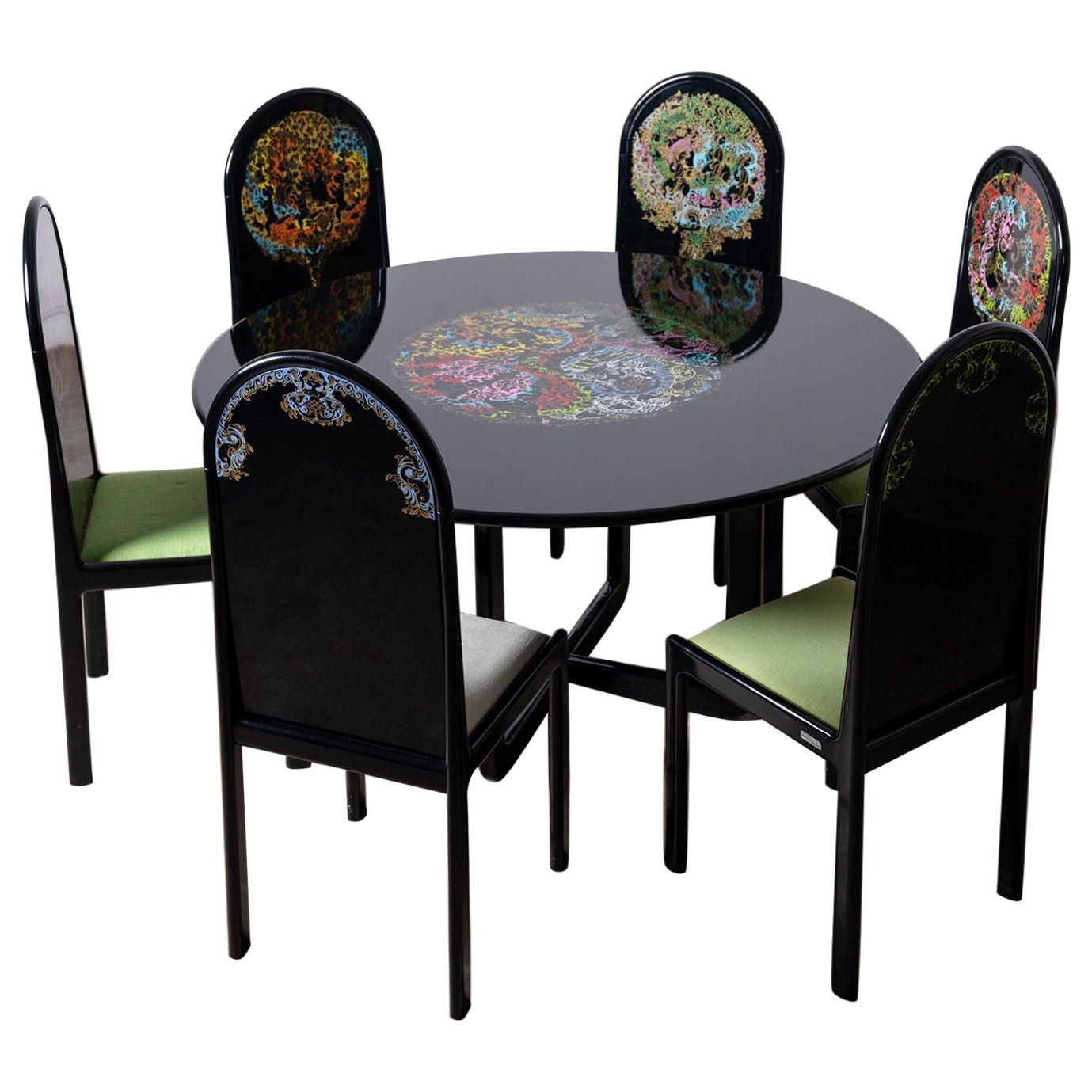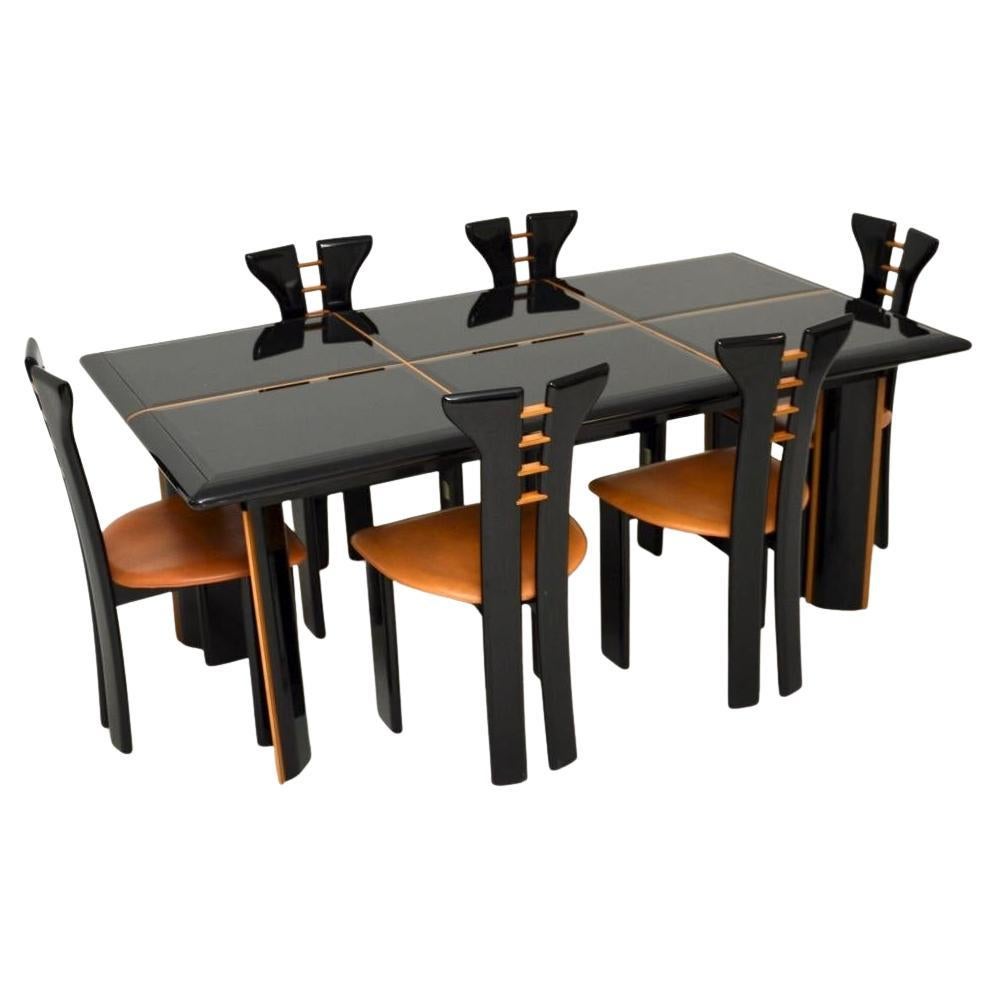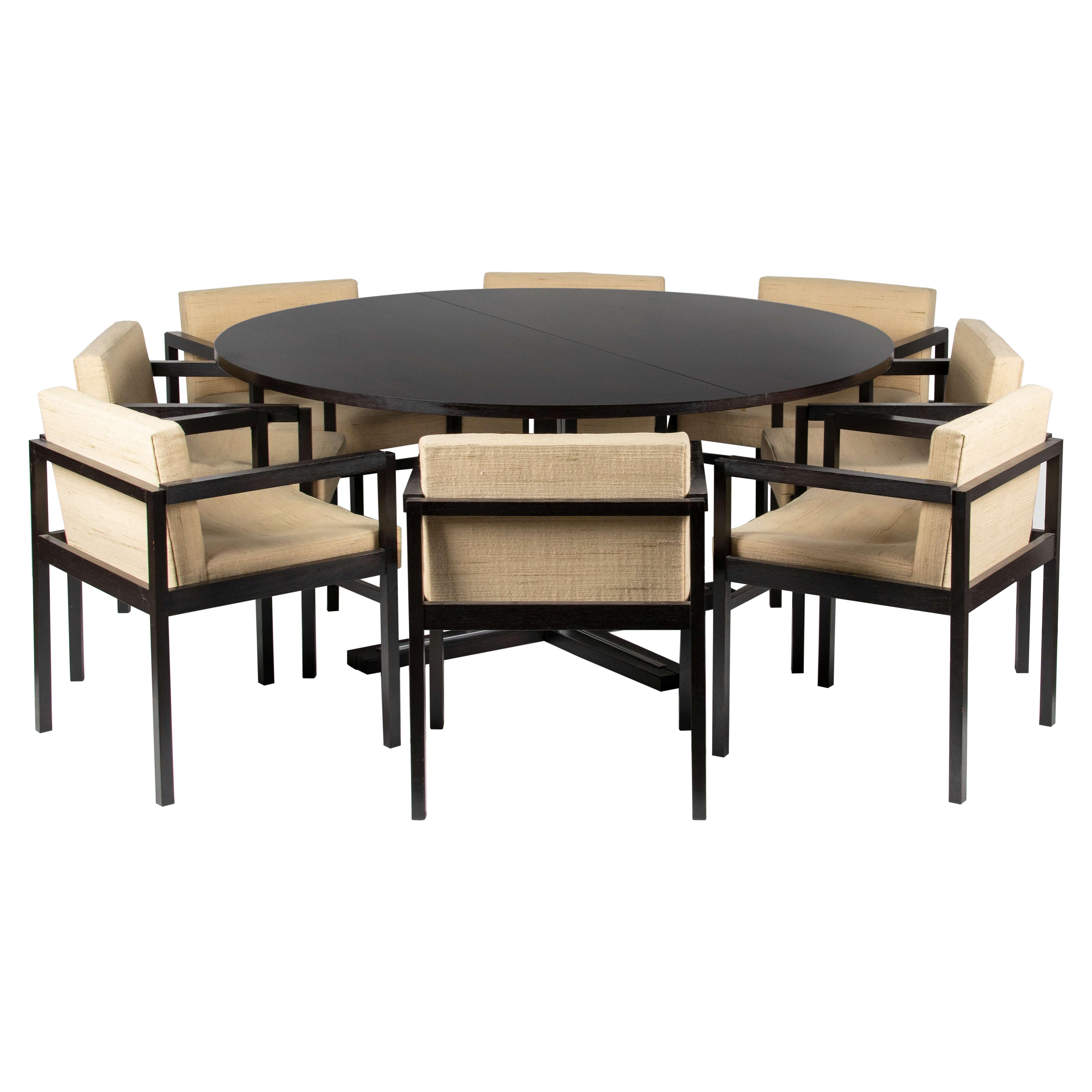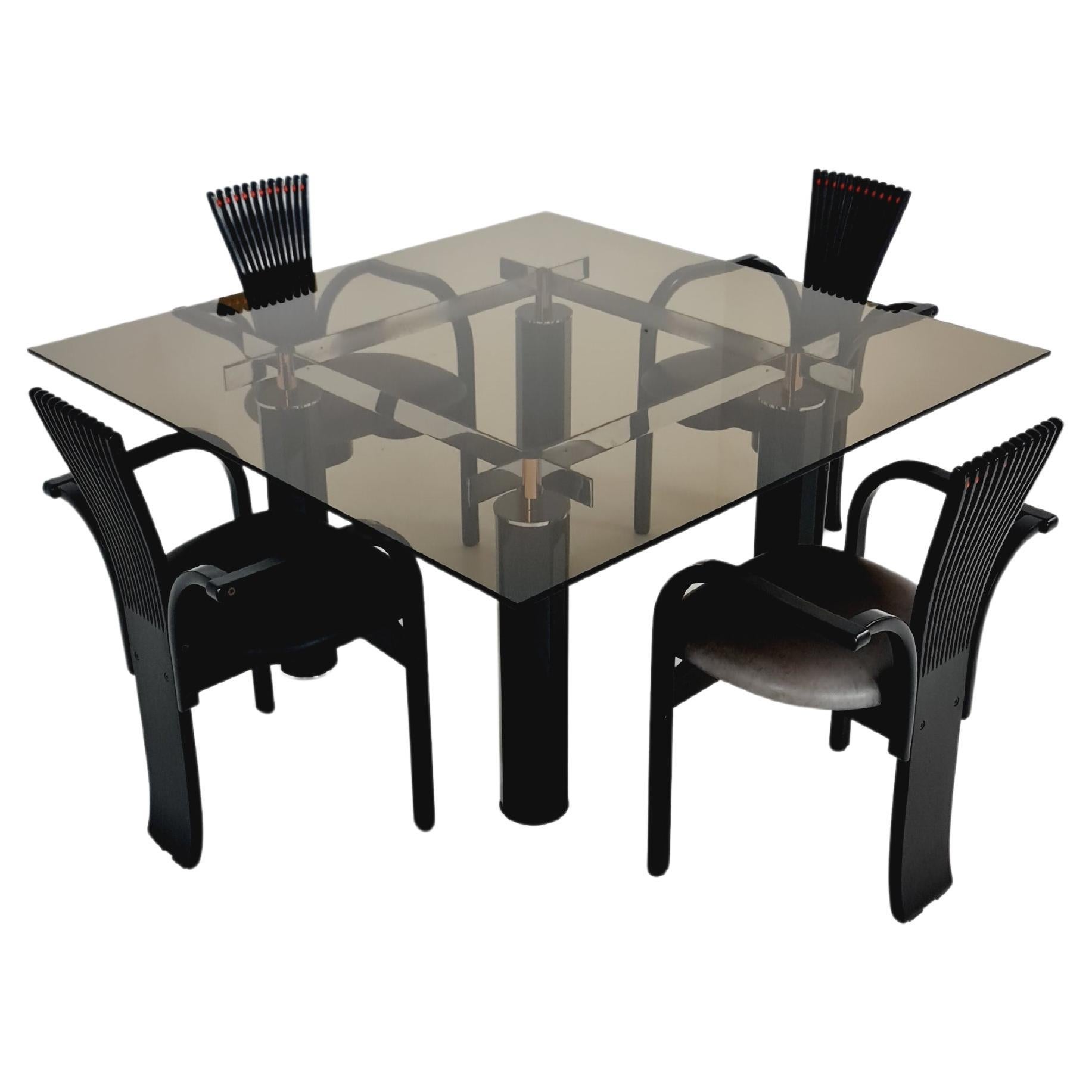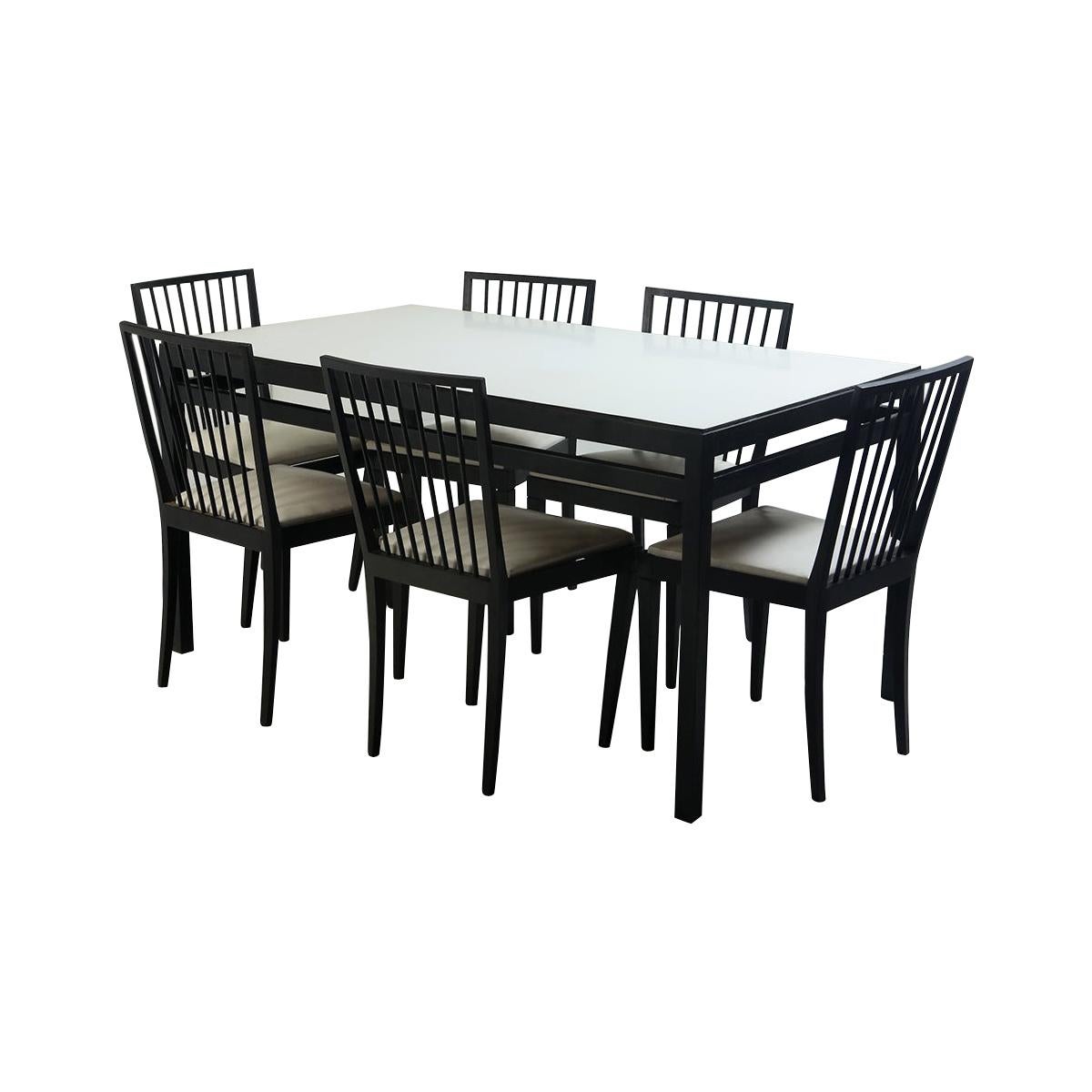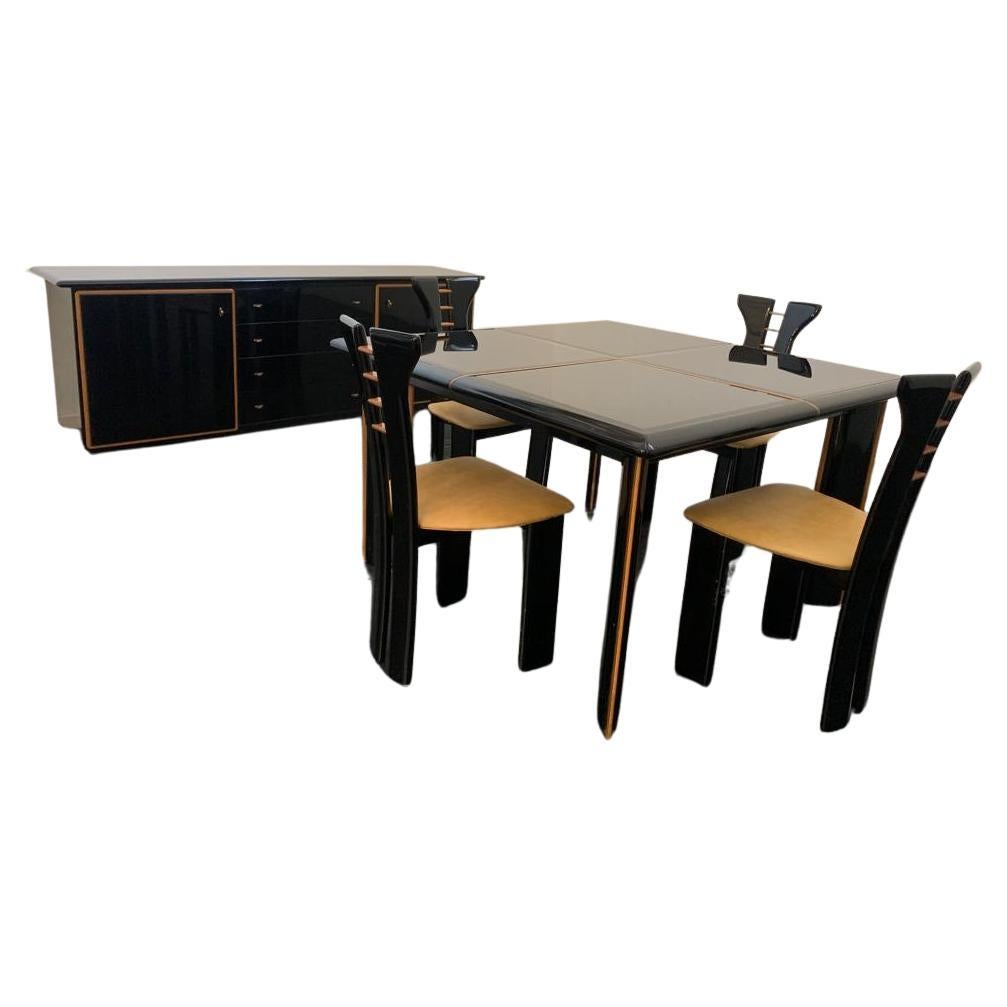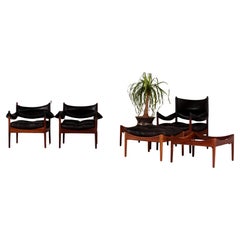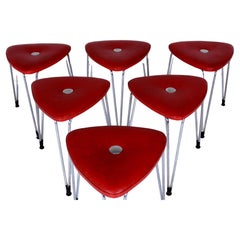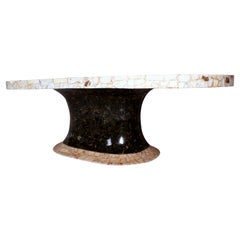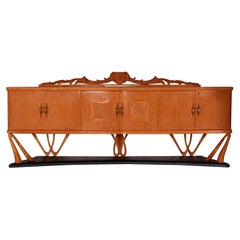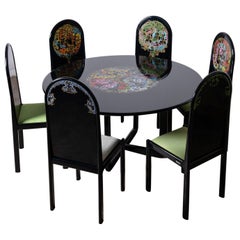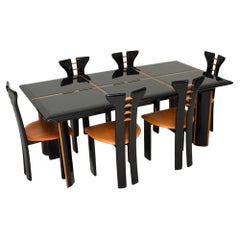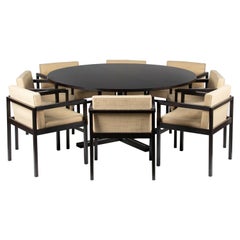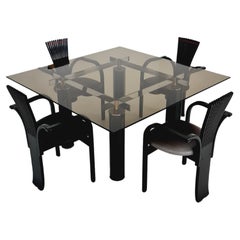Items Similar to Björn Wiinblad for Rosenthal limited art series dining room set table & 8 chairs
Want more images or videos?
Request additional images or videos from the seller
1 of 21
Björn Wiinblad for Rosenthal limited art series dining room set table & 8 chairs
$27,392.48per set
£20,059.68per set
€22,800per set
CA$37,288.02per set
A$41,795.07per set
CHF 21,761.47per set
MX$510,335.68per set
NOK 276,291.55per set
SEK 261,899.54per set
DKK 173,514.95per set
Shipping
Retrieving quote...The 1stDibs Promise:
Authenticity Guarantee,
Money-Back Guarantee,
24-Hour Cancellation
About the Item
THE FOUR CARDINAL POINTS
Rosenthal Kunstmöbelreihe
This noteworthy design is the work of Bjørn Wiinblad.
The furniture pieces were produced in a limited edition of 300 in 1976.
Each table and chair is an original print, rendering each piece a unique entity. The prints were produced by hand under the artist's supervision at the Herbert Geier screen printing studio in Ingolstadt, Southern Germany. The serigraphy technique was employed, utilizing 18 colors. Each item is individually signed and numbered in accordance with the artist's specifications, as outlined in the original contract. The collection comprises a nine-piece ensemble, consisting of eight chairs and a substantial dining table. The material is a black lacquered hardwood.
The set is in remarkable condition and, in this author's estimation, is the most well-preserved set of Wiinblads' "The Four Cardinal Points" art furniture that can be found worldwide.
The dimensions of the set are as follows: the diameter of the dining table is 145 centimetres, and its height is 72 centimetres - the tableboard is reversible.
The chairs have a seat height of 45 centimetres, a depth of 45 centimetres, a width of 43 centimetres, and a total height of 111 centimetres.
About the artist:
Bjørn Wiinblad (1918-2006) is regarded as an artist of considerable versatility, continually reinterpreting himself and his work in pursuit of novel avenues and materials for embellishment.
Fairytale designs imbued with a sense of joy.
Björn Wiinblad's creative output was characterised by a multifaceted approach to artistic expression. He painted oriental ladies and mythical creatures, creating works that evoke joy, fairy tales, and fantasy at a time when minimalism was prevalent. Wiinblad made significant contributions to various artistic disciplines, demonstrating a lifelong dedication to decoration through painting. His unwavering creativity, exuberant Oriental style, and exceptional talent established him as a seminal figure in Danish art, celebrated for his multifaceted contributions to the visual arts.
The Danish artist Bjørn Wiinblad, illustrator, and ceramicist, evinced an early proclivity for artistic pursuits. He was born in Copenhagen in 1918.
He pursued studies in fine art at the Royal Danish Academy of Fine Arts in Copenhagen, graduating in 1943. In 1946, he commenced employment with the Danish pottery Nymølle, which he subsequently assumed control of in 1976. In 1952, he established his own design studio and subsequently commenced employment with the German porcelain manufacturer Rosenthal. In 1957, he was promoted to the position of lead designer for Rosenthal, which provided him with the opportunity to travel throughout Europe and gain international recognition.
In contrast to his contemporaries, who were preoccupied with functional aesthetics, Wiinblad's style was characterized by a delicate and romantic sensibility, with a proclivity for rich colors and undulating lines. These elements were frequently inspired by the fairy tale tradition. His dedication to soulful ceramic design is exemplified by the iconic Magic Flute series (1959) for Rosenthal, a meticulously crafted table service that pays homage to Mozart's opera The Magic Flute. Additional noteworthy designs for Rosenthal include the Romance series (1959), the 1001 Nights series (1969), and the Quatre Couleurs series (Sixties).
While Wiinblad is primarily recognized for his contributions to ceramic design, he also engaged with a diverse range of other artistic mediums. In 1947, he was commissioned by the American Embassy in Paris to design a series of posters. Concurrently, he initiated his career as a costume and set designer for the Royal Theater in Copenhagen, creating designs for Lysistrata (1949), Undine (1962), and Hans Christian Andersen's The Swineherd (1969).
Wiinblad's oeuvre is represented in numerous museums and permanent collections across the globe, including the Victoria & Albert Museum in London, the Museum of Modern Art in New York, and the National Museum in Stockholm.
shipping:: Shipping ::
I'd be more than happy to offer you the most competitive shipping option if you just provide me with your postcode!
For the fastest and most secure shipping, your item will be shipped by us: air freight and perfectly packed in a custom-made wooden OSB board box on pallet (aprox. 160cms x 140cms x 175cms high) DAP (Delivery At Place).
- Creator:Bjorn Wiinblad (Artist)
- Dimensions:Height: 27.96 in (71 cm)Diameter: 57.09 in (145 cm)Seat Height: 17.72 in (45 cm)
- Sold As:Set of 9
- Style:Space Age (Of the Period)
- Materials and Techniques:
- Place of Origin:
- Period:
- Date of Manufacture:1974
- Condition:
- Seller Location:Landshut, DE
- Reference Number:1stDibs: LU8587242509032
About the Seller
5.0
Gold Seller
Premium sellers maintaining a 4.3+ rating and 24-hour response times
1stDibs seller since 2023
21 sales on 1stDibs
Typical response time: 4 hours
- ShippingRetrieving quote...Shipping from: Bodenkirchen , Germany
- Return Policy
Authenticity Guarantee
In the unlikely event there’s an issue with an item’s authenticity, contact us within 1 year for a full refund. DetailsMoney-Back Guarantee
If your item is not as described, is damaged in transit, or does not arrive, contact us within 7 days for a full refund. Details24-Hour Cancellation
You have a 24-hour grace period in which to reconsider your purchase, with no questions asked.Vetted Professional Sellers
Our world-class sellers must adhere to strict standards for service and quality, maintaining the integrity of our listings.Price-Match Guarantee
If you find that a seller listed the same item for a lower price elsewhere, we’ll match it.Trusted Global Delivery
Our best-in-class carrier network provides specialized shipping options worldwide, including custom delivery.More From This Seller
View AllMODUS by Kristian Solmer Vedel SET of 3 lounge chairs 1 stool & 2 coffee tables
By Kristian Solmer Vedel
Located in Landshut, BY
This set was designed by Kristian Solmer Vedel for the renowned Søren Willadsen Møbelfabrik in Denmark.
It boasts excellent original condition.
The set includes two lounge armchair...
Category
Vintage 1960s Danish Scandinavian Modern Stools
Materials
Aluminum
SET of SIX mid-century STOOLS by Günter Talos Vienna chrome iron pin legs 1950s
By Günter Talos
Located in Landshut, BY
SOLID HEAVY DUTY MADE FOR THE ETERNITY
Six mid-century stools designed and made in Vienna around 1950 by J. A. Talos, Vienna XII. Bezirk , Dörfelstraße 6-8 .
The architectually sig...
Category
Vintage 1950s Austrian Mid-Century Modern Stools
Materials
Chrome, Iron
Marble Oval Tulip Dining or Conference Table Muller's of Mexico with Brass Inlay
By Muller of Mexico
Located in Landshut, BY
The table is an exquisite and unique piece of craftsmanship, hand-made in the 1970s by Muller of Mexico. It is crafted from green and ebony colour marble, with a lined surface of ov...
Category
Vintage 1970s Mexican Mid-Century Modern Dining Room Tables
Materials
Marble, Brass
One of a Kind Italian Midcentury Sideboard with Bar Cabinet a. Vittorio Dassi
By Vittorio Dassi
Located in Landshut, BY
Italian 1950s
one of a kind
BAR / SIDEBOARD
attributed to Vittorio Dassi
birch root veneer - solid birch "feet" - stained glass top - mirrored bar compartment - carved upper orna...
Category
Vintage 1950s Italian Mid-Century Modern Sideboards
Materials
Stained Glass, Birch, Burl
Duilio " Dubé " Bernabe Italian coffee table Marble and Bronze Relief
By Duilio Dubé Bernabe
Located in Landshut, BY
It is our great pleasure to confirm that both the stand and the board are, in fact, original and remain in their original condition.
This rectangular coffee table was designed by D...
Category
Vintage 1950s Italian Mid-Century Modern Coffee and Cocktail Tables
Materials
Carrara Marble, Brass
Midcentury set of 2 solid cherry wood wingback armchairs & sofa Karl Nothhelfer
Located in Landshut, BY
just beautiful
SET of Sofa & 2 Wingback Armchairs
by Prof. Karl Nothelfer - Designed in 1957
maker: Schörle & Gölz in Stuttgart - Bad Cannstatt
solid Cherry Wood
new upholstery and fabrics in 1998 according to last owner ( since then just in use for 2 years so upholstery is perfect ! )
Seatrests can be removed - and fixed by clips on belts
- high class -
measurements:
easy chair is 70cm wide ~ sofa is 178cm wide
both: seating height 40cm ~ seating depth: 57cm
condition - all firm and in very good condition - no damages
furniture have fully been accurately cleaned ::
- 3 steps: A: air pistol - B: industrial hoover - C: latest Kärcher "wash&hoover" technology
- woods have been polished several times
note: please ask for shipping quote by sending us your postcode/destination
Prof. Karl Nothelfer
* 14 June 1900 ~~ + 20 May 1980
Since the beginning of the 15th century, the Nothelfer family of carpenters has been continuously resident in the former
town of Überlingen without interruption. Every carpenter at that time mastered
all the possibilities of woodworking: so did the Nothelfer. They could carpenter,
even carve altars and figures, and set them in gold, silver and paint.
(churches in Owingen and Hödingen]. Some family members lived and worked
and worked in Hedingen or Hödingen,like today the jubilarian Karl Nothelfer (this in 1975).
His father, Karl Anton Nothelfer, as the eldest of seven siblings, was able to take over his father's carpentry business in Überlingen.
Karl Anton Nothelfer, the eldest of seven siblings, was unable to take over his father's carpentry business in Überlingen.
He instead moved to the industrial town of Singen with his young wife Rosalie, née Hanner, from the
from Hohenzollern in 1896 and moved to the former Poststraße and founded his own carpenter's workshop.
He had a highsense of quality and form and was already a member of the German Werkbund before 1914.
Karl Nothelfer and his three siblings grew up in such air.
After attending school and the secondary school in Singen, the young Karl learned the carpenter's trade in his father's workshop then moved on to the Badische Landes-Kunstschule in Karlsruhe,
where he studied architecture. At that time the well-known furniture professor also worked there
Fritz Spannagel, born in Freiburg in 1891, who settled in 1938 at Ittendorf Castle near Meers-
burg (died 1957). In 1928, the gifted young architect received a teaching assignment at the
at the Karlsruhe School of Art, but followed his teacher Spannagel to Berlin in the same year.
Berlin. Here he worked from 1928-1945 as a teacher - appointed professor in 1931 - at the
Berlin Tischler-Schule, the later Bauschule für Raumgestaltung.
The furniture he created in Berlin became internationally known through many exhibitions and lectures.
nationally known and influential. His furniture creations ushered in a new era in German and
a new era in German and European furniture design. At the world exhibition in Paris
1937 Prof. Nothelfer was awarded the Golden Medal for his work in the furniture sector.
for his work in the furniture sector. A first summary and balance of his work on furniture is given in his standard work
1942 published standard work "Das Sitzmöbel", the first compendium of its kind in the world.
world. In 1950 he published his second work "Furniture". Both books and a
series of brochures were published by Verlag Otto Maier, Ravensburg.
Karl Nothelfer continued to work intensively on the design of seating furniture in the years after 1945.
In 1950 he succeeded in the important invention of the two-legged skid-base chair, which has been
orthopedically - anatomically tested thousands of times - has become accepted all over the world today.
Even the most distinguished American furniture companies such as Miller or Knoll-International
use the skid as the main theme for desks and chairs. At the same time, N. had a groundbreaking
in the redesign of German school furniture and seating for industry.
industry. He succeeded in adapting his furniture forms, which originated in wood and handicraft, to the modern technical
modern technical possibilities of the industry. He thus became the great refor-
of schoolroom furnishings. The architect Nothelfer thinks about himself,
that he made his main contribution in the field of seating furniture, although this was not
was not really his profession.
After the war, Prof. Nothelfer, like so many others, had to start all over again. He settled
settled in his home town of Lake Constance in Hödingen in 1945 as a freelance architect and was
and was involved in all areas of construction in the years after the war. As early as 1935, he had given many
the example of American prefabricated buildings and recommended serial house
and recommended it at a time when no one in Germany was even thinking about mass production. Now he developed
he developed several types of mass-produced houses, which were manufactured in Baiersbronn.
of which more than 800 houses were built in France alone (types Paris, Provence, Normandie).
were built. At that time [1946], as part of the reparations in Strasbourg, there was an exhibition of houses with Swedish, Danish, and French designs.
with Swedish, Danish, Finnish, English and German houses, where the French occupation
for which 6 different types were sent from the French occupation zone, the
Nothelfer's house type was considered the top of this exhibition.
Karl Nothelfer was also involved in the development of chipboard. In 1946, together with others in Munich, he founded the first
magazine "Bauen und Wohnen" ("Building and Living") after the war and remained its co-editor for many years.
co-editor of this magazine for many years. By presenting his own work, he has here
interpreted what the essence of the magazine wanted to be: Building, in order to live in it, in order to live as a human being and humanly in the built. Karl Nothelfer planned his houses
furniture ground plan, from the need for living. In 1948 he was appointed honorary senator of the State Building
school in Holzminden.
Karl Nothelfer did not build much in Singen. The first post-war house was Haus
Fahr on the slope of the Hohentwiel (Domäne); the building material came from a demolished
log house that a French officer had built for himself on the Schie- nerberg.
nerberg. In 1952, he also built the administration building of the aluminum rolling mill in Singen.
rolling mills in Singen, with relief and wall painting by C. G. Becker. In Überlingen he built
In Überlingen he built, among others, the Buchinger Sanatorium, the Riese+ Hähnel radio house and
various reconstructions in the old town: Haus Kitt with the Glockenspiel, the Haus mit dem
Bacchus in the Überlingen village, the Dolphin Fountain in Hödingen (1975). Probably the most beautiful
Haus Nothelfers, the Haus Himmelheber, stands in Baiersbronn-Tonbach. On the airfield
Mengen, Nothhelfer built the casino building with the 30 square meter faience painting Ikarus by
C. G. Becker. In 1954 he founded a second office with architect Hans Schwingen in Düsseldorf.
Office, which primarily fertilized the housing construction, true to the motto:from the inside to
planning from the outside. The Minister of Housing awarded a prize to the best social housing in North Rhine-
Westphalia; it was from the Nothelfer+Schwingen studio in Düsseldorf. Also the idea of
new idea of home ownership was also promoted by Nothelfer+Schwingen.
promoted by Nothelfer+Schwingen. On the occasion of the red jubilee of the law about condominium ownership
Nothelfer gave a lecture in Essen in 1961 on condominium ownership in Europe (published as a brochure).
published as a brochure]. From Düsseldorf, among many others, in the silk city...
Category
Vintage 1950s German Mid-Century Modern Living Room Sets
Materials
Fabric, Cherry, Upholstery
You May Also Like
Dining Set "Die vier Himmelsrichtungen" by Bjorn Wiinblad for Rosenthal
By Bjorn Wiinblad, Rosenthal
Located in Dallas, TX
Dining set "Die vier Himmelsrichtungen" - "The Four Cardinal Points". This is an exceptional, very beautiful and unique dining set that consist of dining table with six chairs design...
Category
Vintage 1970s German Scandinavian Modern Dining Room Sets
Materials
Wood, Lacquer, Paint
Vintage Italian Dining Table and Chairs by Pierre Cardin for Roche Bobois
By Pierre Cardin, Roche Bobois
Located in London, GB
An outstanding vintage Italian lacquered dining table and chairs by Pierre Cardin for Roche Bobois. This was made in Italy, it dates from around the 1970’s.
The quality is fantastic...
Category
Vintage 1970s Italian Mid-Century Modern Dining Room Sets
Materials
Leather, Glass, Lacquer
Mid-20th Century Wengé Dining Table with 8 Matching Chairs Jules Wabbes style
By Jules Wabbes
Located in Casteren, Noord-Brabant
Beautiful large round wenge dining table with 8 matching chairs in the style of Jules WABBES. The table can be extended with two original leaves. If there are 6 chairs at the table, ...
Category
Vintage 1970s Belgian Mid-Century Modern Dining Room Sets
Materials
Iron
4 Totem dining chairs by Torstein Nilsen for Westnofa, Italian design table
By Torstein Nilsen, Vintage Italian Glass, Westnofa Furniture
Located in Gaggenau, DE
Set of 4 Mid Century Totem dining chairs by Torstein Nilsen for Westnofa with Italian design dining table .Norway 1980s
Beautiful vintage Set of 4 dining chairs, with table ,model Totem, by Torstein Nilsen for Westnofa, Norway.
They are in black wooden fram with feathering slats back, between the slats red wooden balls. 2 chairs seats are black leather other 2 is in dark grey Leather furnishing.
Dining Table is a very special and luxurious vintage Italian design piece. It’s from 1980s
It’s the combination of Black metal hexagon-shaped legs.
Spacers in copper and beveled glass panel complete its design.
It will be the accent of any dining room.
Dimensions
Chairs
width 55 cm
Seat height 51 cm.
Total depth 56 cm
Total height 87 cm
Height arm rests 65.2 cm.
Table -120 cm x 120 cm
Height 72.5 cm
Year -1980's.
In very good condition with minimal wear
You can order 4 set chairs...
Category
Vintage 1980s Norwegian Mid-Century Modern Dining Room Sets
Materials
Brass, Chrome
Mid-Century Modern Set of Dining Table and 6 Chairs by Móveis Flama, Brazil
Located in Deerfield Beach, FL
Mid-Century Modern set of dining table with six chairs by Brazilian Manufacture Móveis Flama, 1950s
This set comprises 1 (one) dining table and 6 (six) chairs. Designed in the 1950s...
Category
Vintage 1950s Brazilian Mid-Century Modern Dining Room Chairs
Materials
Faux Leather, Formica, Wood
$16,480 Sale Price / set
20% Off
Dining Table Set by Pierre Cardin for Roche Bobois, 1970s, Set of 6
By Roche Bobois
Located in Montelabbate, PU
Dining room set by Pierre Cardin for Roche Bobois, 1970s. Black lacquered wood set consisting of four chairs, a table and a sideboard. The table has an extendable glass top (extensio...
Category
Vintage 1970s Italian Modern Dining Room Sets
Materials
Glass, Wood, Lacquer
$6,007 Sale Price / set
33% Off
More Ways To Browse
Black Lacquer Table Sets
American Studio Craft Chair
Printing Table
Danish Painting Ship
Copenhagen Poster
Christian Wood Dining Table
Bjorn Wiinblad Art
Royal Copenhagen Figure
The Graduate Poster
Painted Bentwood Box
Danish Control Dining Table
Rosenthal Flute
Cardinal Chair
Nymolle Bjorn Wiinblad
Bjorn Wiinblad Poster
Magic Flute Bjorn
Rosenthal Magic Flute
Bjorn Wiinblad Magic Flute
